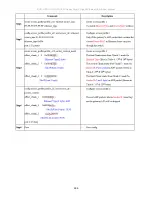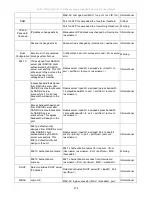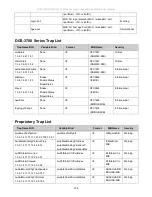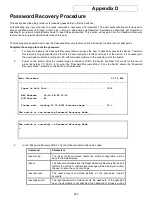
279
LAN - Local Area Network:
A network of connected computing resources (such as PCs, printers, servers) covering a relatively
small geographic area (usually not larger than a floor or building). Characterized by high data rates and low error rates.
latency:
The delay between the time a device receives a packet and the time the packet is forwarded out of the destination port.
line speed
: See baud rate.
main port:
The port in a resilient link that carries data traffic in normal operating conditions.
MDI - Medium Dependent Interface:
An Ethernet port connection where the transmitter of one device is connected to the
receiver of another device.
MDI-X - Medium Dependent Interface Cross-over:
An Ethernet port connection where the internal transmit and receive lines
are crossed.
MIB - Management Information Base:
Stores a device's management characteristics and parameters. MIBs are used by the
Simple Network Management Protocol (SNMP) to contain attributes of their managed systems. The Switch contains its own
internal MIB.
multicast:
Single packets copied to a specific subset of network addresses. These addresses are specified in the destination-
address field of the packet.
protocol:
A set of rules for communication between devices on a network. The rules dictate format, timing, sequencing and
error control.
resilient link:
A pair of ports that can be configured so that one will take over data transmission should the other fail. See also
main port and standby port.
RJ-45:
Standard 8-wire connectors for IEEE 802.3 10BASE-T networks.
RMON:
Remote Monitoring. A subset of SNMP MIB II that allows monitoring and management capabilities by addressing up to
ten different groups of information.
RPS - Redundant Power System:
A device that provides a backup source of power when connected to the Switch.
server farm
: A cluster of servers in a centralized location serving a large user population.
SLIP - Serial Line Internet Protocol:
A protocol, which allows IP to run over a serial line connection.
SNMP - Simple Network Management Protocol:
A protocol originally designed to be used in managing TCP/IP internets.
SNMP is presently implemented on a wide range of computers and networking equipment and may be used to manage many
aspects of network and end station operation.
Spanning Tree Protocol (STP):
A bridge-based system for providing fault tolerance on networks. STP works by allowing you to
implement parallel paths for network traffic, and ensure that redundant paths are disabled when the main paths are operational
and enabled if the main paths fail.
stack:
A group of network devices that are integrated to form a single logical device.
standby port:
The port in a resilient link that will take over data transmission if the main port in the link fails.
switch:
A device, which filters, forwards and floods packets based on the packet's destination address. The switch learns the
addresses associated with each switch port and builds tables based on this information to be used for the switching decision.
TCP/IP:
A layered set of communications protocols providing Telnet terminal emulation, FTP file transfer, and other services for
communication among a wide range of computer equipment.
Telnet:
A TCP/IP application protocol that provides virtual terminal service, letting a user log in to another computer system and
access a host as if the user were connected directly to the host.
TFTP - Trivial File Transfer Protocol:
Allows you to transfer files (such as software upgrades) from a remote device using your
switch's local management capabilities.
UDP - User Datagram Protocol:
An Internet standard protocol that allows an application program on one device to send a
datagram to an application program on another device.
VLAN - Virtual LAN:
A group of location- and topology-independent devices that communicate as if they are on a common
physical LAN.
VLT - Virtual LAN Trunk
: A Switch-to-Switch link which carries traffic for all the VLANs on each Switch.
VT100:
A type of terminal that uses ASCII characters. VT100 screens have a text-based appearance.



































